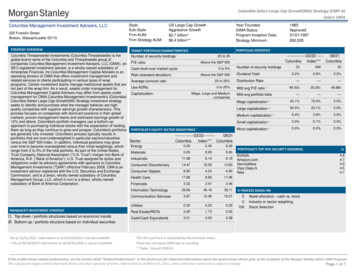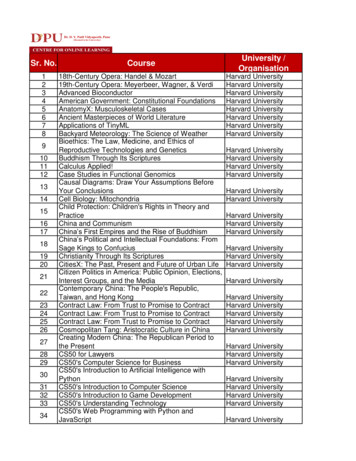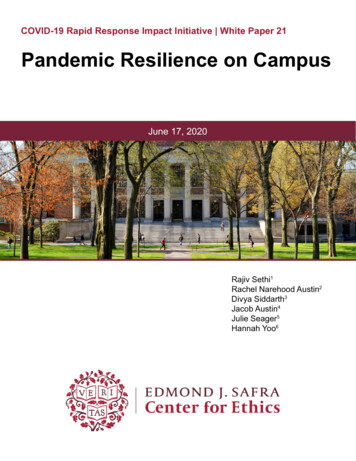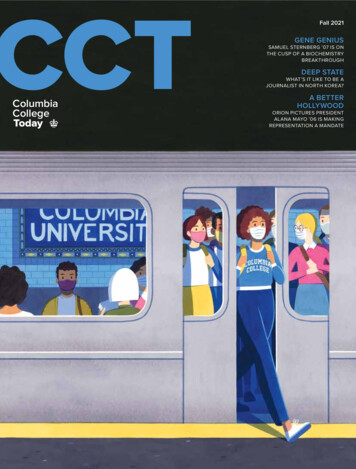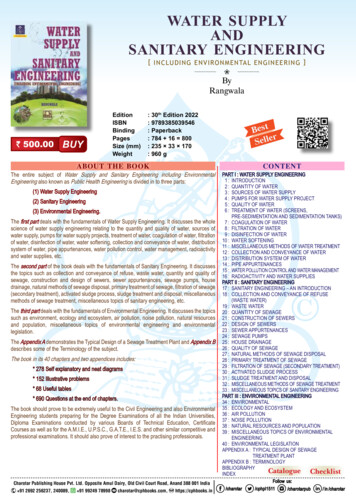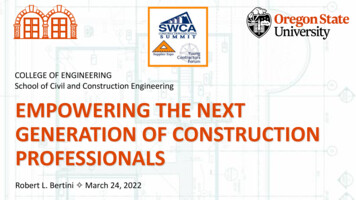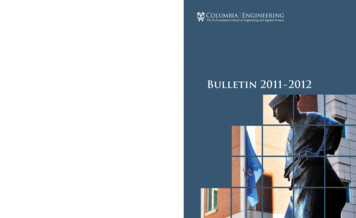
Transcription
Columbia Engineering2011 -2012500 West 120th StreetNew York, New York 10027Bulletin 2011 -2012
Academic Calendar 2011– 2012The following Academic Calendar was correct and complete when complied; however, the University reserves the right torevise or amend it, in whole or in part, at any time. Information on the current Academic Calendar may be obtained in theStudent Service Center, 205 Kent, 212-854-4330, or visit the Registrar’s website at www.columbia.edu/cu/registrar.Undergraduate AdmissionsNeed more information?Office of Undergraduate Admissions212 Hamilton Hall, Mail Code 28071130 Amsterdam AvenueNew York, NY 10027Phone: 212-854-2522Fax: 212-854-3393E-mail: edu/admissionsYou can find the contact informationfor the people who know in theColumbia University Resource Liston pages 242–244 or visit the Columbia Engineeringwebsite, www.engineering.columbia.edu.Financial AidOffice of Financial Aid and Educational FinancingOffice: 618 Lerner HallMailing: 100 Hamilton Hall, Mail Code 28021130 Amsterdam AvenueNew York, NY 10027Phone: 212-854-3711Fax: 212-854-5353Undergraduate Inquiry E-mail: ugrad-finaid@columbia.eduGraduate Inquiry E-mail: ia.edu/finaidGraduate Student ServicesGraduate Admissions, Financial Aid, and Student Affairs524 S. W. Mudd, Mail Code 4708500 West 120th StreetNew York, NY 10027Phone: 212-854-6438Fax: 212-854-5900E-mail: duFor the most current information, visit our onlinebulletin at www.bulletin.engineering.columbia.edu.AUTUMN TERM 2011SPRING TERM 2012August29–Sept. 5January10 –13Registration by appointment for all classes.16 Birthday of Martin Luther King Jr.University holiday.17First day of classes.17–20, 23–27 Change of program by appointment.27 Last day to (1) register for academic credit, (2) change course programs, (3) submitwritten notice of withdrawal from thespring term to the Dean of Student Affairsfor full refund of tuition and special fees.No adjustment of fees for individualcourses dropped after this date.New student orientation program.September2 Registration by appointment for first-yearstudents.5Labor Day. University holiday.6First day of classes.6–9, 12–16Change of program by appointment.16 Last day to (1) register for academic credit, (2) change course programs, (3) submitwritten notice of withdrawal from theautumn term to the Dean of StudentAffairs for full refund of tuition and specialfees. No adjustment of fees for individualcourses dropped after this date.30 Last day to confirm, update, or request a waiver from the Student MedicalInsurance Plan.October1920October degrees conferred.Midterm date.November1 Last day to apply for February degrees.7 Academic holiday.8Election Day. University holiday.14–18Registration by appointment for spring2012.17 Last day to drop Engineering coursesw ithout academic penalty. Last day tochange a grading option.24–25Thanksgiving holiday.December11213–1516–2324–Jan. 16Last day to apply for May degrees.Last day of classes.Study days.Final examinations.Winter holiday.February1 Last day to confirm, update, or request aw aiver from the Student MedicalInsurance Plan.8February degrees conferred.March5Midterm date.12–16Spring holiday.22 Last day to drop Engineering coursesw ithout academic penalty. Last dayto change grading option.April9 –1330Registration by appointment for fall 2012.Last day of classes.May1– 3Study days.4–11Final examinations.5 Last day for continuing students toa pply for financial aid for the 2012–2013academic year.13Baccalaureate Service.14Engineering Class Day.162012 University Commencement.
Bulletin 2011 -2012
Mission of the Engineering SchoolColumbia University’s Fu Foundation School of Engineering and Applied Science, as part of a world-classteaching and research university, strives to educate socially responsible engineering and applied science leaderswhose work results in the betterment of the human condition, locally, nationally, and globally.We push beyond the boundaries of current research by fostering a community of scientific inquiry in criticalareas of knowledge, including “CyberBioPhysicalTM Systems,” where the biological, physical, and digitial worldsintegrate and fuse, and where the innovative solutions will be found to solve current grand challenges in health—in mind and body; sustainability—in energy, climate, or water; information—theoretical or applied; and systems,open or closed.Our School seeks to create an entrepreneurial ecosystem to bring the innovations developed in ourclassrooms and laboratories out into the world to directly improve and enhance society on a global scale.engineering 2011– 2012
a message from the deanAs students of The Fu FoundationSchool of Engineering and AppliedScience at Columbia University, youare part of a long line of engineering andapplied science leaders who have studied atColumbia. Across the centuries, our alumnihave exemplified the excellence, leadership,and impact that defines Columbia Engineering.John Stevens (Class of 1768), inventor of thesteamboat, William Barclay Parsons (Classof 1882), chief engineer of New York’s firstsubway line, Robert C. Merton (Class of 1965),Nobel laureate in economics, and NASAAstronauts Gregory Johnson (Class of 1985),who successfully piloted the space shuttleEndeavour on its last mission, and Michael J.Massimino (Class of 1984), who twice repairedthe Hubble Space Telescope, are but someexamples.You are among the select few who havejoined our community for an education thatwill enable you to become part of the nextgeneration of socially responsible engineeringand applied science leaders whose workresults in the betterment of the humancondition. You, too, will become part of thehistory of this School, which is inextricablyentwined with Columbia University’s and withthe city of New York.We foster an engineering educationparadigm that is symbolized by the Greekletter π. The first support column of theπ is the depth of knowledge you gain inyour engineering or applied science major.The second is the knowledge you acquirethrough a minor, or your involvementin entrepreneurship initiatives, researchopportunities, and community-based servicelearning. The overarching connector of thesetwo foundations, the crossbeam of the π, isColumbia’s famed liberal arts Core Curriculum,the umbrella that positions engineering andapplied science within the context of thelarger society, for the betterment of the humancondition and the sustainability of our planet.Some of you will choose to make an impactby bringing together your knowledge andleadership in pandisciplinary research, perhapsin an area that I call “CyberBioPhysical Systems”—where the biological, physical, anddigital worlds intersect and fuse. These areasbring together our knowledge of sensors,materials, nanotechnology, and biologicalsystems and hold promise as a frontier for thedevelopment of innovative solutions to the mostchallenging problems of modern society.You are part of a School that offers greatopportunities for learning and advancementwithin a premier research university that issituated in the vibrant and cosmopolitan cityof New York. I encourage you to take fulladvantage of all these opportunities.Feniosky Peña-MoraDeanengineering 2011– 2012
table of contents About the School andUniversity1History of the SchoolResources and Facilities25Undergraduate Studies9the Undergraduate Programs 10Policy on Degree Requirements10The First-Year/Sophomore Program10Study Abroad13Combined Plan Programs15The Junior-Senior Programs16 Programs in Preparation for17Other ProfessionsJoint Programs18Registered Programs18 Undergraduate Admissions Admission as a First-Year StudentApplicants with Advanced StandingCampus Visits and Interviews20202122Undergraduate TUITION,FEES, AND PAYMENTS23FINANCIAL AID FORUNDERGRADUATE STUDYDetermining EligibilityFinancial Aid AwardsHow to Apply for Financial AidTax Withholding for NonresidentA lien Scholarship andFellowship Recipients2525262627Graduate Studies29The graduate programsThe Master of Science DegreeThe Professional Degree Doctoral Degrees: Eng.Sc.D.and Ph.D.Special Nondegree Students30303132columbia video network34graduate admissions35graduate tuition, fees,and payments37financial aid for graduatestudyFinancing Graduate Education Instructions for Financial AidApplicants39333939Graduate School DepartmentalFundingAlternative Funding Sources Other Financial Aid—Federal,State, and Private ProgramsEmploymentContact 01201203Campus and Student LifeCampus life205206student services211Scholarships, Fellowships,Awards, and Prizes215227Faculty and Administration43Departments and AcademicPrograms53key to course listings54applied physics andapplied mathematics56University and SchoolPolicies, Procedures, andRegulations69academic proceduresand standards228biomedical engineeringchemical engineering80academic standing232civil engineering andengineering mechanics91policy on conduct anddiscipline234computer engineeringprogram102essential Policies for thecolumbia communitycomputer science107238earth and environmentalengineering120student grievances,academic concerns, andcomplaintselectrical engineering134241industrial engineeringand operations research152Directory of UniversityResourcesColumbia universityresource list242materials science andengineering program168mechanical engineering176Undergraduate Minors189Interdisciplinary Coursesand Courses in OtherDivisions of the University195Interdisciplinary 196engineering coursescourses in other divisionsof the universityBiological SciencesBusinessChemistry Earth and Environmental SciencesHumanities and Social Sciences197197197197198200237maps 245index247Academic Calendar (see inside backcover)
About the School and University
2history of the schoolA Colonial CharterSince its founding in 1754, as King’sCollege, Columbia University has alwaysbeen an institution both of and for theCity of New York. And with an originalcharter directing it to teach, amongother things, “the arts of Number andMeasuring, of Surveying and Navigation,. . . the knowledge of . . . various kindsof Meteors, Stones, Mines and Minerals,Plants and Animals, and everythinguseful for the Comfort, the Convenienceand Elegance of Life,” it has also alwaysbeen an institution of and for engineers.Engineers for anIndustrial RevolutionAn early and influential graduate from theschool was John Stevens, Class of 1768.Instrumental in the establishment of U.S.patent law, Stevens procured manypatents in early steamboat technology,operated the first steam ferry betweenNew York and New Jersey, receivedthe first railroad charter in the U.S., builta pioneer locomotive, and amassed afortune, which allowed his sons to foundthe Stevens Institute of Technology.The Gilded AgeAs the city grew, so did the school.King’s College was recharteredas Columbia College in 1784, andrelocated from the Wall Street area towhat is now Midtown in 1857. Studentsbegan entering the new School of Minesin 1864. Trained in mining, mineralogy,and engineering, Columbia graduatescontinued to make their mark both athome and abroad.engineering 2011– 2012Working around the globe, WilliamBarclay Parsons, Class of 1882, wasan engineer on the Chinese railway andthe Cape Cod and Panama Canals,and, most importantly for New York,chief engineer of the city’s first subway.Opened in 1904, the subway’s electriccars took passengers from City Hallto Brooklyn, the Bronx, and the newlyrenamed and relocated ColumbiaUniversity in Morningside Heights, itspresent location on the Upper West Sideof Manhattan.A Modern Schoolfor the Modern EraThe School of Mines became the Schoolof Mines, Engineering, and Chemistry in1896, and its professors—now calledthe Faculty of Engineering and AppliedScience—included Michael IdvorskyPupin, a graduate of the Class of 1883.As a professor at Columbia, Pupin didpioneering work in carrier-wave detectionand current analysis, with importantapplications in radio broadcasting;invented the “Pupin coil,” which extendedthe range of long-distance telephones;and taught classes in electromechanics.An early student of Pupin’s was IrvingLangmuir. Graduating in the Class of1903, Langmuir enjoyed a long career atthe General Electric research laboratory,where he invented a gas-filled tungstenlamp; contributed to the development ofthe radio vacuum tube; extended GilbertLewis’s work on electron bonding andatomic structure; and did research inmonolayering and surface chemistry,which led to a Nobel Prize in chemistryin 1932.But early work on radio vacuumtubes was not restricted to privateindustry. Working with Pupin, anengineering student named EdwinHoward Armstrong was conductingexperiments with the Audion tube in thebasement of Philosophy Hall when hediscovered how to amplify radio signalsthrough regenerative circuits. Graduatinga year later, in the Class of 1913,Armstrong was stationed in Franceduring the First World War, where heinvented the superheterodyne circuitto tune in and detect the frequenciesof enemy aircraft ignition systems.After the war Armstrong improvedhis method of frequency modulation(FM) and by 1931 had both eliminatedthe static and improved the fidelity ofradio broadcasting forever. The historicsignificance of Armstrong’s contributionswas recognized by the U.S. governmentwhen the Philosophy Hall laboratory wasdesignated a National Historic Landmarkin 2003.The Nuclear AgeAs the United States evolved into amajor twentieth-century political power,the University continued to build ontoits undergraduate curriculum thebroad range of influential graduateand professional schools that define ittoday. Renamed once again in 1926,the School of Engineering preparedstudents for careers not only asengineers of nuclear-age technology,but as engineers of the far-reachingpolitical implications of that technologyas well.
3After receiving a master’s degreefrom the School in 1929, AdmiralHyman George Rickover served duringthe Second World War as head of theelectrical section of the Navy’s Bureauof Ships. A proponent of nuclear seapower, Rickover directed the planningand construction of the world’s firstnuclear submarine, the 300-foot-longNautilus, launched in 1954.The Technological AgeToday, The Fu Foundation School ofEngineering and Applied Science, asit was named in 1997, continues toprovide leadership for scientific andeducational advances. Even JosephEngelberger, Class of 1946, the fatherof modern robotics, could not haveanticipated the revolutionary speed withwhich cumbersome and expensive “bigscience” computers would shrink to thesize of a wallet.In 1986 the Engineering School wasone of the first schools in the countryto use videotapes as tools for distancelearning. Today Columbia VideoNetwork continues to be in the forefrontof distance learning at the graduate levelthrough its online education programs.Named as one of Forbes Magazine’s“Best of the Web,” CVN offers theopportunity for students anywhere in theworld to enroll in certificate programs orobtain a master’s or professional degreefrom Columbia Engineering via the web.The New CenturyNo one could have imagined theexplosive growth of technology and itsinterdisciplinary impact. The EngineeringSchool is in a unique position to takeadvantage of the research facilitiesand talents housed at Columbia toform relationships among and betweenother schools and departments withinthe University. The School’s newestdepartment, Biomedical Engineering,with close ties to the Medical School,is but one example. Interdisciplinarycenters are the norm, with crossdisciplinary research going on inbiomedical imaging, environmentalchemistry, materials science, medicaldigital libraries, nanotechnology, digitalgovernment, new media technologies,and GK-12 education. The Schooland its departments have links to theDepartments of Physics, Chemistry,Earth Science, and Mathematics, aswell as the College of Physicians andSurgeons, the Graduate School ofJournalism, Lamont-Doherty EarthObservatory, Teachers College,Columbia Business School, and theGraduate School of Architecture,Planning and Preservation. Thetransforming gift of The Fu Foundationhas catapulted the School into theforefront of collaborative research andteaching and has given students theopportunity to work with prize-winningacademicians, including Nobel laureates,from many disciplines.The New ResearchFor the past several years, Columbiahas been among the handful of researchuniversities that earn the largest patentincome from inventions created byits faculty. The University is the onlyacademic institution that holds patentsin the patent pool for the manufactureof MPEG-2, the technology thatengineering 2011– 2012
4enables DVDs and high definition TV.Another exciting patent that holds greatpromise is a laser-based method thatmakes possible, among other things,the sharper display screens found inhigh-end smart phones. Sequentiallateral solidification (SLS) is based onbreakthrough research in understandinghow a substance is rapidly meltedand solidified. The result is an optimalcrystalline material that enables a newgeneration of smart phones. Within ashort time, thanks to the innovationstaking place in Columbia Engineeringlabs, it may be possible to put an entirecomputer on a sheet of glass or plastic.Engaged EntrepreneurshipEntrepreneurship has emerged as animportant central educational themewithin The Fu Foundation School ofEngineering and Applied Science. Theengineering 2011– 2012School promotes engineering innovationand engaged entrepreneurship througha range of programs and offers a15-credit, interdisciplinary minor inentrepreneurship made up of bothEngineering and Business Schoolcourses. The School also provides afour-year entrepreneurship experiencefor all interested Columbia Engineeringstudents, regardless of major.A Forward-LookingTraditionBut, for all its change, there is stilla continuous educational threadthat remains the same. ColumbiaEngineering still remains an institutionof manageable size within a greatuniversity. Committed to the educationalphilosophy that a broad, rigorousexposure to the liberal arts provides thesurest chart with which an engineer cannavigate the future, all undergraduatesmust complete a modified but equallyrigorous version of Columbia College’scelebrated Core Curriculum. It is theseselected courses in contemporarycivilization in the West and other globalcultures that best prepare a student foradvanced course work; a wide range ofeventual professions; and a continuing,life-long pursuit of knowledge,understanding, and social perspective.It is also these Core courses that mostclosely tie today’s student to the alumniof centuries past. Through a sharedexposure to the nontechnical areas, allColumbia Engineering students—past,present, and future—gain the humanistictools needed to build lives not solely astechnical innovators, but as social andpolitical ones as well.
Resources and FacilitiesA College within theUniversityA unique educational opportunity, The FuFoundation School of Engineering andApplied Science at Columbia Universityoffers programs to both undergraduateand graduate students who undertakea course of study leading to thebachelor’s, master’s, or doctoral degreein engineering and applied science.Combining the advantages of a smallcollege with the extensive resources ofa major research university, studentsat Columbia Engineering pursue theiracademic interests under the guidanceof outstanding senior faculty memberswho teach both undergraduate andgraduate level courses. Encouraged bythe faculty to undertake research at alllevels, students at the School receivethe kind of personal attention that onlyColumbia’s exceptionally high facultystudent ratio affords.The New York AdvantageBesides the faculty, the single greatestfacility at a Columbia student’sdisposal is without doubt the Cityof New York. Within easy reach bywalking, bus, subway, or taxi, NewYork’s broad range of social, cultural,and business communities offer anunparalleled opportunity for students toexpand their horizons or deepen theirunderstanding of almost any humanendeavor imaginable. With art fromsmall SoHo galleries to major Uptownmuseums; music from Harlem jazzclubs to the Metropolitan Opera; theaterfrom performance art in the East Villageto musicals on Broadway; food fromFrench on the Upper East Side to Asianin Chinatown; and sports teams fromthe Jets to the Yankees, New York isthe crossroads of the world.New York is fast becoming amajor player in high-tech researchand development, where Fortune 500companies traded on Wall Street seekpartnerships with high-tech start-upventures in Tribeca. As part of theresearch community themselves,Columbia students have exceptionalopportunities for contact with industryboth on and off campus. Seniorrepresentatives of these companiesoften visit Columbia to lecture as adjunctfaculty members or as special speakers,and undergraduate and graduatestudents frequently undertake researchor internships with these and othercompanies, oftentimes leading to offersof full-time employment after graduation.In addition to its ties to privateindustry, Columbia also has a historicallyclose relationship with the public sectorof New York, stretching back to theeighteenth century. No other city inthe world offers as many impressiveexamples of the built environment—the world’s most famous collectionof skyscrapers, long-span bridges,road and railroad tunnels, and oneof the world’s largest subway andwater supply systems. Involved in allaspects of the city’s growth and capitalimprovements over the years, Columbiaengineers have been responsible for thedesign, analysis, and maintenance ofNew York’s enormous infrastructure ofmunicipal services and communicationslinks, as well as its great buildings,bridges, tunnels, and monuments.5The University at LargeColumbia University occupies two majorcampuses, as well as additional specialpurpose facilities throughout the area.Besides the main campus located onthe Upper West Side in MorningsideHeights, further uptown in WashingtonHeights is the Health Sciences campus,which includes Columbia’s medicalschool (the College of Physicians andSurgeons), the Mailman School of PublicHealth, the New York State PsychiatricInstitute, and other health professionsprograms. The Health Sciences Divisionis an equal partner with NewYorkPresbyterian Hospital in the ColumbiaMedical Center, the world’s firstacademic medical center. The medicalcenter opened in 1928 when Columbia’shealth-related schools and PresbyterianHospital (which has since merged withNew York Hospital to become NewYorkPresbyterian Hospital) moved to theWashington Heights location. ColumbiaEngineering’s Biomedical EngineeringDepartment has offices on both theMorningside and Health Sciencescampuses.Beyond its schools and programs,the measure of Columbia’s true breadthand depth must take into account itsseventy-odd internationally recognizedcenters and institutions for specializedresearch, which study everything fromhuman rights to molecular recognition,as well as the close affiliations it holdswith Teachers and Barnard Colleges,the Juilliard School, the AmericanMuseum of Natural History, and boththe Jewish and Union TheologicalSeminaries. Columbia also maintainsengineering 2011– 2012
6major off-campus facilities such as theLamont-Doherty Earth Observatoryin Palisades, N.Y., and the NevisLaboratories in Irvington, N.Y. Involvedin many cooperative ventures, Columbiaalso conducts ongoing research atsuch facilities as Brookhaven NationalLaboratory in Upton, N.Y., and theNASA Goddard Institute for SpaceStudies located just off the Morningsidecampus.The Morningside HeightsCampusThe Fu Foundation School ofEngineering and Applied Science islocated on Columbia’s Morningsidecampus. One of the handsomesturban institutions in the country, thethirty-two acres of the Morningsidecampus comprise over sixty buildingsof housing; recreation and researchfacilities; centers for the humanitiesand social and pure sciences; andprofessional schools in architecture,business, the fine arts, journalism, law,and other fields.The Fu Foundation Schoolof Engineering and AppliedScienceThe Fu Foundation School ofEngineering and Applied Scienceoccupies four laboratory andclassroom buildings at the northend of the campus, including therecently completed Northwest CornerScience and Engineering Building,a new interdisciplinary teaching andresearch building on the Morningsidecampus. It was designed by theworld-renowned architect Jose RafaelMoneo to serve as a physical andintellectual bridge, linking laboratoriesand maximizing the ready sharingand exchange of ideas, resources,and information. With its beehive-likesetting, the new building is alreadyenhancing existing collaborationsand stimulating new ones, enablingresearchers across the University towork together to create new areas ofknowledge, in fields such as “CyberBioPhysical Systems,” where thebiological, physical, and digital worldsfuse. This pandisciplinary frontier isthe nexus at which engineering andapplied scientific advances will provideengineering 2011– 2012innovative solutions to some of modernsociety’s most challenging problemsin health, sustainability, information,and systems. With the School’s closeproximity to the Northwest CornerScience and Engineering Building andthe many other Morningside facilitiesand programs, Columbia Engineeringstudents have ready access to thewhole of the University’s resources.Offering multiple programs of study,with facilities specifically designed andequipped to meet the laboratory andresearch needs of both undergraduateand graduate students, the School isthe site of an almost overwhelmingarray of basic and advanced researchinstallations, from the Columbia GenomeCenter and Nanoscale Science andEngineering Center to the School’snewest major center, the Energy FrontierResearch Center, which is examiningnew and more efficient ways to extractsolar energy. Details about specificprograms’ laboratories and equipmentcan be found in the sections describingthose programs.columbia EngineeringComputing FacilitiesThe Botwinick Multimedia LearningLaboratory at Columbia Universityhas redefined the way engineers areeducated here.Designed with both education andinteraction in mind, the lab providesstudents and instructors with 50 stateof-the-art Apple Mac Pro workstationsconnected to central servers and anetwork-based RAID storage array, afull set of professional-grade engineeringsoftware tools, and a collaborativeclassroom learning environment to helpthem engage in real-world interactionswith community clients, Engineeringfaculty, and professional practitioners.It is home to the School’s introductoryfirst-year engineering course, as well asadvanced classes in 3-D modeling andanimation, technology and society, andentrepreneurship.The classroom features a widescreen SMART Board, two highdefinition LCD projectors, and a SonyEVI-HD1 PTZ camera with direct-to-diskrecording via HD-SDI using a Kona3video capture card.Central ComputingResourcesColumbia University InformationTechnology (CUIT)Helpdesk Support Center202 Philosophy HallMonday–Friday: 10:00 a.m.– 6:00 p.m.Phone: 212-854-1919Monday–Thursday: 8:00 a.m.–11:00 p.m.Friday: 8:00 a.m.–7:00 p.m.Saturday: 10:00 a.m.– 6:00 p.m.Sunday: 3:00 p.m.–11:00 p.m.E-mail: CUIT provides Columbia Universitystudents, faculty, and staff with amyriad of central computing andcommunications services, includingColumbia’s wireless and high-speedcampus Ethernet network, available to allstudents in residence hall rooms. CUITalso manages an array of computer labs,terminal clusters, ColumbiaNet kioskstations, electronic classrooms, andprovides a variety of technical supportservices via the CUIT Helpdesk.CUIT services include the following: E-mail accounts and CubMail, aWeb-based program for accessingColumbia e-mail. It provides a secureand convenient way to send andreceive mail from anywhere, using anyWeb browser. Computer account IDs provideaccess to Columbia’s secure onlineinformation resources, campuscomputer labs, and printing on CUITprinters. All Columbia students, faculty,and staff are assigned an ID account(called University Network ID or UNI). Columbia’s website providesaccess to hundreds of onlineservices and resources, includingextensive academic, scholarly, andadministrative resources, a myriadof library catalogs and references,the Directory of Classes, registrationinformation, campus publications, andevents listings. Technical support is available throughthe CUIT Helpdesk, which providestechnical assistance to students onthe Morningside campus online, byphone, or in person. (See beginningof this section for hours and contactinformation.)
C ourseWorks is the University coursemanagement system. It allowsinstructors to easily develop andmaintain course websites, distributeclass materials, link to online reserves,administer quizzes and tests,communicate with students, andpromote online discussions. Electronic classrooms are equippedwith multimedia capabilities such ascomputer and projection systems,DVD and CD-ROM players, VCRs, andaudio systems. Public computer kiosks are availablein various locations around theMorningside campus for accessingColumbia’s web resources and e-mail. Computer labs and clusters providestudents, faculty, and researchers withaccess to a range of software. Somelocations have consultants to providelab help. Printing facilities are availablethroughout the Morningside campusand Barnard College. These highspeed, high-volume printers arelocated in CUIT computer labs,libraries, residence halls, and othercomputer clusters and electronicclassrooms. Computer security is extremelyimportant at Columbia and CUITprovides several resources onlin
Graduate Admissions, Financial Aid, and Student Affairs 524 S. W. Mudd, Mail Code 4708 500 West 120th Street New York, NY 10027 Phone: 212-854-6438 Fax: 212-854-5900 E-mail: seasgradmit@columbia.edu www.engineering.columbia.edu Need more information? You can find the contact information for the people who know in the Columbia University .
